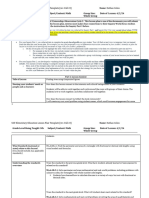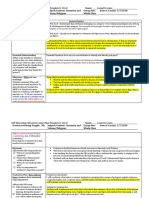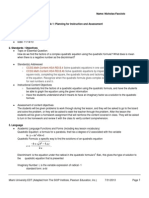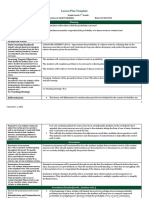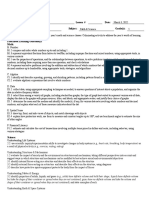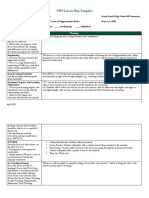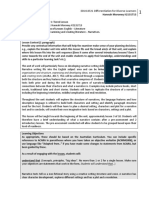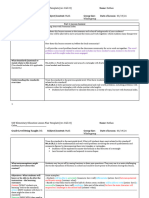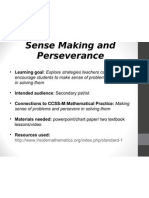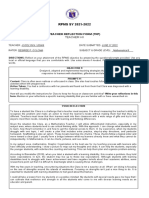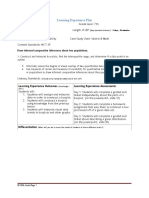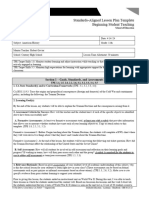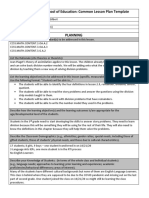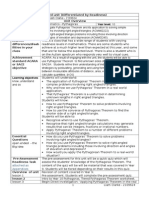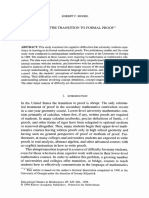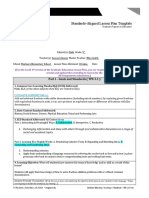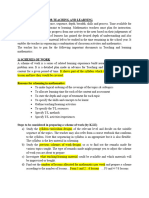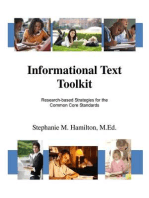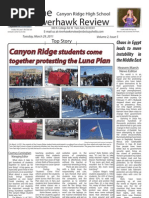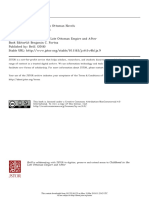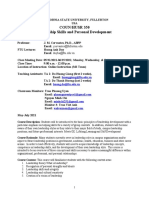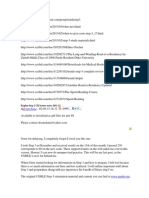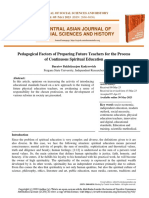Mge Lesson Plan Template Math 1
Mge Lesson Plan Template Math 1
Uploaded by
api-445501321Copyright:
Available Formats
Mge Lesson Plan Template Math 1
Mge Lesson Plan Template Math 1
Uploaded by
api-445501321Original Title
Copyright
Available Formats
Share this document
Did you find this document useful?
Is this content inappropriate?
Copyright:
Available Formats
Mge Lesson Plan Template Math 1
Mge Lesson Plan Template Math 1
Uploaded by
api-445501321Copyright:
Available Formats
MGE Lesson Plan Template – Mathematics
Complete this lesson plan in enough detail so that another teacher or substitute can replicate it. This lesson plan
serves as a representation of your content and pedagogical knowledge, so be thorough.
Be sure to consider your learner as you plan this lesson: You are teaching young adolescents, so recall information
from EDUC 2130, EDMG 3300, and other coursework. You are encouraged to provide citations often (when
appropriate) and a reference list to develop the habit in preparation for your edTPA
Name Amber Johnson . Grade & Subject 6th grade / Mathematics .
Class Duration 50 minutes . School & CT Kennesaw State MS / Dr. Lawler .
I. Context for Learning
Provide a description of your school, class, and student contexts. School information should include:
• basic community information: SES- lower middle class, 76.3% of students are eligible for free
lunch.
• school type and grade levels; Middle school, grades 6th-8th grade
• special features of your school or classroom setting (e.g., charter, co-teaching, themed
magnet, remedial course, honors course) that will affect your teaching in this learning
segment; 5 class periods a day and 2 of the class periods are co-taught with a Special
Education teacher in the classroom during those class periods.
• district, school, or cooperating teacher requirements, or expectations that might affect your
planning or delivery of instruction, such as required curricula, pacing plan, use of specific
instructional strategies, interdisciplinary teaming, or standardized tests. Interdisciplinary
teaming with a Language Arts teacher, Mathematics teacher, Social Studies Teacher, and
Science Teacher. There is required curricula and pacing plan for the Georgia Standards of
Excellence.
Class information should include:
• name and length of the course, class schedule (e.g. 50 minutes every day); 6th grade
mathematics. 50 minutes a class period every day.
• describe how ability grouping and/or tracking affects your class; Students will be placed into
groups based in groups on their summative assessment grade and also their behavior.
• name of textbook or instructional program you primarily use for mathematics instruction;
and My Math, Grade 6 published by McGraw-Hill 2013
• list of other resources regularly used for mathematics instruction. Electronic whiteboard and
document camera.
Student information should include:
• grade level and student ages;
o Grade level: 6th grade
o Student ages: 11-12 years old
• number of students, including broken out by gender identities;
o 1st period: 8 males and 14 females -22 students
o 2nd period: 13 males and 15 females -28 students
o 3rd period: 15 males and 12 females -27 students
MGE Lesson Plan Template Lawler
Mathematics 1 rev. 10 apr 2019
o 4th period: 14 males and 15 females-29 students
• what you’ve learned about student funds of knowledge that may be drawn upon in this lesson
or lesson segment; Students have many extend family in parts of US, Central America, and
South America. I draw upon this for the finding the area of the Bermuda Triangle.
• required or needed supports, accommodations, and modifications for students that impact
this lesson or lesson segment. You should consider students with IEPs, 504 Plans, language
needs, and others such as students identified as gifted, struggling readers, underperforming,
or with gaps in academic knowledge.
Learning Needs # of Supports, accommodations, modifications,
Category Students and/or relevant IEP goals
Struggling readers 29 Extended time to read directions and
(2nd period) directions read to them. Some students
during test have the test questions read to
them
Struggling readers 33 Extended time to read directions and
(3rd period) directions are occasionally read to them.
Some students that reading grades below
grade level have the test and quizzes read to
them.
Students with IEPS 9 Based on their accommodations in their plans
or 504 plans (2nd are the ones implanted into the class
period)
Students with IEPS 10 Based on their accommodations in their plans
or 504 plans (3rd are the ones implanted into the class
period)
Click to enter text
II. Mathematical Content
A. Central Focus
The purpose of this lesson segment is applying the student’s prior knowledge of using find area of
different shapes to solve real-world and mathematical problems involving area, surface area, and
volume (6.G.A, Cluster A). The conceptional understanding of this lesson segment is area formula
for a triangle which is 1/2 base X height. The procedural fluency for this lesson segment the
practice of find the area of the Bermuda triangle. The mathematical reasoning for this lesson is
that students have to work together and explain their thought process with fellow classmates.
This lesson segment will serve as a building block forth understanding for surface area and
volume of different 3D shapes.
B. State Standards
List one mathematics content standard most central to this lesson. List one mathematics practice
standard you will emphasize developing in this lesson. List one additional standard from a second
content area your lesson contributes toward.
MGE Lesson Plan Template Lawler
Mathematics 2 rev. 10 apr 2019
Content Standard: MGSE6. G.1 Find area of right triangles, other triangles, quadrilaterals, and
polygons by composing into rectangles or decomposing into triangles and other shapes; apply
these techniques in the context of solving real-world and mathematical problems.
Practice Standard: 4 Model with mathematics. In grade 6, students model problem situations
symbolically, graphically, tabularly, and contextually. Students form expressions, equations, or
inequalities from real world contexts and connect symbolic and graphical representations.
Students begin to explore covariance and represent two quantities simultaneously. Students use
number lines to compare numbers and represent inequalities. They use measures of center and
variability and data displays (i.e. box plots and histograms) to draw inferences about and make
comparisons between data sets. Students need many opportunities to connect and explain the
connections between the different representations. They should be able to use all of these
representations as appropriate to a problem context.
C. Learning Objectives
1. Mathematics Content
Students will make a connection between the area formula of the triangle and the area
formula for a parallelogram through finding the area of a triangle using real-world scenario
by the given map and locations of important cities.
2. Mathematics Practice
Students will create a model contextually for area of a triangle through the provide
information form the teacher.
3. Interdisciplinary/Integrative Objectives
Identify an objective paired to the non-mathematics standard listed in II.B. Provide a brief
description of how this lesson connects to these cross-curricular standards.
ELAGSE6RI5 Analyze how a particular sentence, paragraph, chapter, or section fits into the
overall structure of a text and contributes to the development of the ideas.
Students will analyze how parallelograms and triangles are similar and used together
through the map of the Bermuda Triangle.
D. Mathematical Understanding
Describe how the standard(s) and learning objective(s) in this lesson contribute to students’
development of conceptual understanding, procedural fluency, and mathematical reasoning
and/or problem solving.
The conceptional understanding of this lesson segment is area formula for a triangle which is
1/2 base X height. The procedural fluency for this lesson segment the practice of find the area
of the Bermuda triangle. The mathematical reasoning for this lesson is that students have to
work together and explain their thought process with fellow classmates.
III. Instructional Strategies and Learning Tasks
Provide an overview of the lesson by describing the Launch, Explore, and Summarize phases.
Respond in a way that would allow another teacher to carry out the activity as you imagine and that
makes clear connections to the learning objective(s). In each section, organize your response by
describing the sequence of events and approximate times. Write out the important statements you
will make and questions you will ask.
MGE Lesson Plan Template Lawler
Mathematics 3 rev. 10 apr 2019
A. Anticipatory Set – i.e. Launch
A brief introductory activity or question that engages students’ curiosity, activates their
background knowledge, builds background when needed, focuses their thoughts on the learning
objective, and ensures all students have access to the learning task. Should be directly related to
the instructional objective. This lesson opener may be an opportunity to draw out initial
conceptions students have about the topic. List specific questions you will use to provoke wonder
in (to puzzle) your students. List specific prompts that guide or direct activity.
Launch will take about 10-15 mins depending on the class participation.
• What area of the world is displayed on the screen? (The teacher will show a map
of the Bermuda Triangle)
• Does anyone have a story or experience in this area?
• There is a myth surround the Bermuda triangle. Can anyone tell about the myth?
• So how big of an area do planes and ships have avoided?
• Talk with your elbow pair and come up with your estimate on how big is the
Bermuda Triangle?
o Also discuss what things you need to know to find the area of a triangle.
• Students will write their estimates on the board; the teacher will ask the whole
class if certain estimates are too small or too big.
B. Learning Tasks – i.e. Explore
Describe the learning tasks, specifically providing evidence how the task provides students
opportunity to achieve the learning objectives. During the lesson, students must engage in
cognitively demanding tasks and be supported during paired or small group discussion. List
specific prompts that initiate activity for this phase. List specific questions you anticipate will be
helpful to advance or extend student reasoning. Briefly describe the types of responses to the
task you anticipate from students, and how you plan to sequence these responses for discussion.
• As individuals, students will work through the problem before working in groups (2-3
minutes)
• Students will work in groups to work and discuss the problem. (15-20 minutes)
o The problem is to find the area of the triangle of the Bermuda Triangle. Students
will be given the distance between the cities that create the Bermuda Triangle.
• Students might have these questions?
o Where do we begin?
o Why do we have the 4th location of Springfield, VA?
o We find the area of the Bermuda Triangle now what?
C. Closure – i.e. Summarize
An activity that helps students bring together the experiences of the lesson and identify what
they have learned. A student-centered summary that engages students in discussion is an
effective way to do this. A student-centered summary begins with several students sharing
solution methods with one another. Next, the teacher helps students draw connections between
their solutions and other’s solutions, as well as the key mathematical ideas in the lesson. An
effective lesson concludes with the teacher restating these key mathematical ideas learned
during the lesson, and possibly foreshadowing what comes next—hopefully a new wondering
MGE Lesson Plan Template Lawler
Mathematics 4 rev. 10 apr 2019
raised as a result of the lesson. List specific concluding comments to summarize the important
learning of the lesson.
Groups will present and share their findings. Groups will write down their answers on the
white. The teacher will select a couple of groups to share how they arrived at the
conclusion that they did.
Some Prompting Questions:
• What steps did you/your group make to find the area of the Bermuda Triangle?
• What formula did you group use to discover the area of the Bermuda Triangle?
• What shapes did you create for the locations on the map to discover the Bermuda
Triangle?
The teacher will have a guided discussion with students about make the connection that the
formula for area of a triangle is half of the area formula for a parallelogram.
IV. Assessments
In your responses to the three sections below, cite resources that justify the value and
appropriateness of the assessment methods you’ve identified.
A. Assessment of Prior Knowledge
How will you assess prior academic learning and prerequisite skills related to the central focus?
Describe formal or informal pre-assessment activities that will help you determine what resources
(i.e. funds of knowledge: skills, knowledge, experiences, and interests) students bring to the
lesson.
Note: A deficit-orientation focuses on misconceptions, partial understandings, and
misunderstandings. An asset-orientation focuses on what children know and can do (their
"conceptions"), as well as their interests and wonderings. Respond with a greater emphasis on an
asset- or resource-based orientation rather than deficit-orientation. What understandings, ideas,
and/or wonderings do the students bring that you can build upon or provoke them to refine?
N/A
B. Formative Assessments
Formative assessments provide information needed to adjust teaching and learning while they
are still occurring, i.e. a checkpoint for understanding that guides future instructional decisions.
This type of assessment can take place during or at the conclusion of a learning activity or lesson.
The purpose is to monitor progress toward the learning objective(s) and/or central focus.
In your description, be specific in terms of what you want students to demonstrate (must be
measurable and connected to your listed objectives) and how you will obtain the information you
are seeking (oral, written response, etc.). As a part of what, discuss which of conceptual
understanding, procedural fluency, or reasoning and/or problem solving your assessment targets.
As part of how, state the specific questions to be posed for the assessment when appropriate.
1. Informal Formative
Informal formative assessments monitor student progress during or after instruction, but
do not usually result in structured feedback. Informal assessments can be used to obtain
information about individuals or groups. These may include responding to student
questions and teacher observations made during student work.
MGE Lesson Plan Template Lawler
Mathematics 5 rev. 10 apr 2019
Students will write on a sticky not-one thing they learned specifically from the lesson just
taught that day and one thing they would like to have more practice on. For this specific
lesson, students will reflect on the make connections between the parallelogram area
formula and the triangle area formula in the context of a real-world word problem.
2. Formal Formative
Formal assessments are designed in such a way to allow the teacher to provide individual
feedback. Students respond individually, verbally or in writing, to a question or task.
Typically, the teacher’s assessment of these responses is documented in some way. These
may include quizzes, exit tickets, journals, homework, projects, and performance tasks.
The formal formative assessment for this lesson will be an exit/enter ticket of the door. At
the end of the lesson or the beginning of class of the next day, students will answer the 4
questions on the board on a slip of paper with their name on it.
The 4 questions will be:
• What is the triangle are formula compared to the parallelogram are formula?
• What is the are of a background with a fence that creates one point will one side of
the house? The house side is 50 feet and the point of the fence is 90 feet at a
perpendicular angle.
• How can you derive the triangle area formula from the parallelogram are formula?
• What is one thing you learned in the lesson and one thing that you need more
practice on?
C. Summative Assessments
Evaluates student learning at the end of an instructional unit by comparing it against some
standard or benchmark. The purpose is to demonstrate attainment of the objective(s).
Summative assessments provide information about each individual student. Assuming the lesson
does not conclude with a summative assessment, briefly state how and when the objective(s)
from this lesson will be summatively assessed.
At the end of this unit of surface area, volume, and area, the students will have a project as their
summative assessment for this unit. The students will create a map of a city. The will provide
measurements of the areas for each building, park, or object on the map. Students will also
create 3D figures of some of the buildings. The buildings that are 3D, the students will provide the
measurements of the surface area and the volume of that building. The standard of finding the
area of different shapes will be met and assessed during the first part of the summative
assessment with the creation of the map and finding the measurement of the areas.
V. Academic Language
The language demands of a learning task include any of the receptive language skills (e.g., listening,
reading) or the productive language skills (e.g., speaking, writing) needed by the student in order to
engage in and complete the task successfully. Your responses below should describe how you will
provide opportunity for students to engage in these skills.
A. Language Functions
These are the measurable verbs embedded in your objectives, i.e. describe, explain, justify, prove,
compare/contrast, etc. List the language functions for your lesson here. Describe how the
language functions you have listed allow students to engage in both receptive and productive
MGE Lesson Plan Template Lawler
Mathematics 6 rev. 10 apr 2019
language skills to increase content understandings, e.g., how does the act of analysis engage
students in learning as it relates to your content.
• Make a connection:
Students will engage in productive language skills because they are creating a connection
between the locations on the map and understanding that the area formula for triangles are
derived from area formula of a parallelogram. Students will be talking and discussing in groups
to be able to share ideas on how to find the area of the Bermuda Triangle. Though the talking
and sharing of ideas is the productive language skills.
• Create:
Students will engage in productive language skills because they will be producing a product
of a model to find the area of triangle to share within small groups and whole class
discussion.
B. Vocabulary
A. List vocabulary in the lesson that has different meanings across subject areas, providing the
multiple definitions.
• Distance- This vocabulary word has a couple of different meanings across different
contents. Distance can mean the avoidance of familiarity and/or reserve. Distance in this
lesson’s context is the amount of space between two things or people. For this task,
students will have to find the distance between cities that form the Bermuda triangles.
• Area- This vocabulary word has a general meaning that can be used across different
contents. The definition of area is a region or part of a town, a country, the world, or object.
For this task, students will discover the area of the Bermuda triangle.
• Base- This vocabulary word has a few different meanings in different subjects. One of the
meaning is the lowest part or edge of something. Example the base of a tree. The second
meaning is a conceptual structure or entity on which something draws or depends. An
example is the town’s economic base collapsed. For this lesson, the meaning of the
vocabulary word is the first meaning of that was given; the lowest part of something. For
this lesson the base with the lowest part of the shape on the map. For this task, students
will be using the base measurement in the area formula to find the area of the Bermuda
Triangle.
• Height- This vocabulary word has a couple different meanings. One of the meanings is the
measurement from base to top or from head to foot. The other meaning is the most
intense part or period of somethings. In this lesson the meaning being used is the
measurement from base to top. For this task, students will be using the height of the shape
in the area formula to find the area of triangle.
B. List subject-specific vocabulary for your lesson here and provide the appropriate definition.
• Triangle: This vocabulary word has a specific definition for mathematics. The definition
for triangle is a plane figure with three straight sides and three angles. The main part of
the learning task is to find the area of a triangle, so you have to have a triangle to find
the area of that shape.
• Parallelogram: This vocabulary word has a specific definition for mathematics. The
definition for parallelogram is a four-sided plane rectilinear figure with opposite sides
parallel. This term is included because the students in the learning task are given
information that creates a parallelogram on the map and the students are to derive the
area formula for triangles from the area formula of the parallelogram.
MGE Lesson Plan Template Lawler
Mathematics 7 rev. 10 apr 2019
C. Describe how the structure of the learning tasks allow students to learn and engage with
the vocabulary you listed here, enhancing the learning of subject-specific vocabulary.
The structure of the learning task allows students to engage with the terms of height, base,
area, distance, triangle and parallelogram. The students will be discussing in groups, so the
students can use these terms to describe what they are doing through the process of
solving the word problem.
C. Syntax
Identify any specific syntax, i.e. the rules, special forms, conventions, and/or grammar associated
with (academic) writing or speaking in mathematics, that is part of this lesson. Describe how you
plan to teach the syntax, and provide opportunity for students to engage with the syntax with
both receptive and productive language skills. Note if no syntax is introduced during this lesson.
The syntax for this learning is the area formula for a triangle and parallelogram. The area formula
for triangle area is ½ b*h. The area formula for a parallelogram is b*h. B represents the
measurement of the base in the figure. H represents the measurement of height in the figure.
Students will be engaging with the syntax of this learning task through receptive language
skills of listening from the teacher summarizing the methods into the formula. The teacher
will be doing this during the summarize portion of the lesson.
D. Discourse
Describe how you will use or facilitate discourse in which your students participate in both
receptive and productive language tasks that serve to demonstrate or increase an understanding
of content including the academic language you are teaching. There will likely will be multiple
opportunities for and forms of discourse throughout your lesson for you to describe. Include
citations for the discourse structures you identify.
Students will be working in small groups to share (speaking and listening) that help increase their
understanding of the problem and finding the area of the Bermuda triangle. The students will also
be writing down their ideas and other groups ideas to fully understand that the concepts of
finding area of any triangle.
VI. Support for Varied Student Learning Needs
This section allows you to describe how the lesson has been differentiated for the young adolescent
student population described in Section I, context for learning, to develop conceptual understanding,
procedural fluency, and mathematical reasoning and/or problem-solving skills. In your responses to
the three sections below, cite resources that justify the value and appropriateness of the instructional
strategies you’ve identified.
A. Build on student resources
Describe how you have designed or modified the learning task(s) in response to what you learned
in the pre-assessment about resources students bring to the lesson: their funds of knowledge and
their academic/mathematical assets.
Based off the gathering of the funds of knowledge of the classes, students know about the
Bermuda Triangle. Some students have family in that area, they have been themselves or they
know someone that has been to the area. Having students answering some prompting questions
to engage prior knowledge in the Launch proportion of the lesson, this will insure that all students
MGE Lesson Plan Template Lawler
Mathematics 8 rev. 10 apr 2019
have some kind of understanding of the area in which they are using to discover the concept of
area formula of a triangle.
B. Respond to learning needs of the whole class
Identify the instructional strategies that provide opportunities for all students, given the variety
of physical, cognitive, emotional, social, and behavioral development among adolescents in a
middle grades classroom. Specifically, identify how students have multiple options to engage in
learning and/or to demonstrate what they have learned. (Identify the differentiation and/or
Universal Design for Learning strategies implemented.)
Differentiation on
Content (what the student is learning): Students will be given the options to choose from in
choice of different real-world problems to find the area of different shaped areas in the world.
Process (how the student accesses the information or the way in which the student engages with
the content): Tiered instruction with some students jumping right into the learning task. Some
students will work through smaller tasks to guide them to the finally answer. The groups that are
working through smaller tasks at a time will be given task cards.
Product (how students demonstrate their knowledge or mastery of the content): Students will
have the option to present their findings verbally in front of the class or visually in the whole class
discussion in the summarize portion of the lesson.
C. Respond to learning needs of individuals and groups with similar needs
How you will support the needs of the individuals and groups with similar needs—including
emergent bilinguals (ELs), students with IEP's, etc.—that you identified in Section I. (Name
specific modifications or accommodations, specifically as they related to the lesson design and
learning objectives.)
Struggling readers accommodations/ modifications: When the teacher provides instructions, the
instructions will be read aloud so students hear the instructions and see the instructions on the
board or the on page.
Students with IEP’s accommodations/ modifications: Depending on the individual plan for the
student, they might have more time to work through assignments, have instructions read to
them, learn content from audiobooks, movies, videos, and digital media instead of reading print,
have help coordinating assignments in a book or planner. There more accommodations available
but it depends on the Individual plan.
VII. Preparation
A. Materials Needed
List all materials needed by the teacher and the students for the lesson; assume that students
have writing paper and utensils.
• A class set of a map with the Bermuda Triangle drawn out.
• Have access for students that want to use a calculator.
• Power Point to help with the Launch portion of the lesson.
o https://docs.google.com/presentation/d/12hB-
wjAphCVVQ5iGbHsxI1lxxNjDX2TUJ22ITwjhFVg/edit?usp=sharing
MGE Lesson Plan Template Lawler
Mathematics 9 rev. 10 apr 2019
B. Resources
List all resources used in the development of this lesson, including books, websites, and other
teachers. Cite all sources appropriately.
Kaplinsky, R. (2013, September 25). How Big Is The Bermuda Triangle? Retrieved March, 2019,
from https://robertkaplinsky.com/work/bermuda-triangle/
Miles, R. H., & Williams, L. A. (2018). Your Mathematics Standards Companion, Grades 6-8.
Thousand Oaks, CA: Corwin.
VIII. Reference List
You are encouraged to provide citations often in your responses above (when appropriate) and a
reference list for those citations, to develop the habit in preparation for your edTPA. Your citations
throughout the paper and reference list provided here must adhere to the guidelines defined in the APA
Publication Manual (6th Ed.).
Kaplinsky, R. (2013, September 25). How Big Is The Bermuda Triangle? Retrieved March, 2019, from
https://robertkaplinsky.com/work/bermuda-triangle/
Little, C. A., Hauser, S., & Corbishley, J. (2009). Constructing Complexity for Differentiated Learning.
15(1). Retrieved April, 2019.
Lynch, S. D., Hunt, J. H., & Lewis, K. E. (2018). MTMS Favorites: “Productive Struggle for All:
Differentiated Instruction”. Mathematics Teaching in the Middle School, 23(4).
Miles, R. H., & Williams, L. A. (2018). Your Mathematics Standards Companion, Grades 6-8. Thousand
Oaks, CA: Corwin.
MGE Lesson Plan Template Lawler
Mathematics 10 rev. 10 apr 2019
You might also like
- Edtpa Planning CommentaryDocument7 pagesEdtpa Planning Commentaryapi-214069084100% (2)
- g4 Area and Perimeter UnitDocument20 pagesg4 Area and Perimeter Unitapi-249159678No ratings yet
- Curriculum Mapping and Curriculum Quality Audit: Lesson 3.3Document7 pagesCurriculum Mapping and Curriculum Quality Audit: Lesson 3.3Liza Maramag100% (5)
- Impact of The Anti-Intellectual Attitudes To The Level of Self-Esteem of Senior High School Students From Fiat Lux Academe-Cavite, PhilippinesDocument15 pagesImpact of The Anti-Intellectual Attitudes To The Level of Self-Esteem of Senior High School Students From Fiat Lux Academe-Cavite, PhilippinesLee NicoNo ratings yet
- Scale Lesson PlanDocument8 pagesScale Lesson Planapi-314719374No ratings yet
- Geometry Strategies For Middle School: The Van Hiele LevelsDocument10 pagesGeometry Strategies For Middle School: The Van Hiele Levelssorindani1234100% (1)
- MgelessonplantemplatemathDocument10 pagesMgelessonplantemplatemathapi-445318193No ratings yet
- CT Observation 2Document10 pagesCT Observation 2api-703594419No ratings yet
- Assignment 2 4 - Unit Plan Lesson PlanDocument28 pagesAssignment 2 4 - Unit Plan Lesson Planapi-332241858No ratings yet
- EDCI572 001 05B HjalmarsonDocument7 pagesEDCI572 001 05B HjalmarsonMOHALIDIN ALIDNo ratings yet
- Planning CommentaryDocument8 pagesPlanning CommentaryShealagh Lyons100% (1)
- Math Mge Lesson PlanDocument7 pagesMath Mge Lesson Planapi-444425700No ratings yet
- Supervisor Observation Lesson Plan Cycle 2Document12 pagesSupervisor Observation Lesson Plan Cycle 2api-294525510No ratings yet
- Aaron Newton and Michael Legg Unit PlanDocument8 pagesAaron Newton and Michael Legg Unit Planapi-391876964No ratings yet
- Edma360 Assessment 3-4 4 1Document17 pagesEdma360 Assessment 3-4 4 1api-265542260No ratings yet
- Mathlessonplan Perimeter AreaDocument8 pagesMathlessonplan Perimeter Areaapi-316754926No ratings yet
- QuadraticformulalessonDocument23 pagesQuadraticformulalessonapi-252581591No ratings yet
- Lesson Plan Template: Essential QuestionDocument6 pagesLesson Plan Template: Essential Questionapi-550336195No ratings yet
- Voulme Lesson 1Document4 pagesVoulme Lesson 1api-330599039No ratings yet
- Ms Chapter2Document12 pagesMs Chapter2johnbrixbalazonespenocillaNo ratings yet
- Mathematics Pedagogical PDFDocument7 pagesMathematics Pedagogical PDFYeit Fong TanNo ratings yet
- RPMS Movs For Obj 9Document13 pagesRPMS Movs For Obj 9ampedradNo ratings yet
- 3121 Trek Lesson PlanDocument22 pages3121 Trek Lesson Planapi-661751964No ratings yet
- Movs For Obj 9Document13 pagesMovs For Obj 9Daniel Talahiban MalabarbasNo ratings yet
- Edu 412strategy Based Comp Plan 1Document8 pagesEdu 412strategy Based Comp Plan 1api-666825575No ratings yet
- Final Educ4721 Lesson PlanDocument12 pagesFinal Educ4721 Lesson Planapi-373579135No ratings yet
- Supervisor Observation 2Document8 pagesSupervisor Observation 2api-630693076No ratings yet
- Unit PlanDocument15 pagesUnit Planapi-356505889No ratings yet
- Updated Lesson PlansDocument25 pagesUpdated Lesson Plansapi-455080964100% (1)
- Eb-Good Math Lesson PlansDocument37 pagesEb-Good Math Lesson PlanschoocghNo ratings yet
- Lesson 8-Planning For Teaching and LearningDocument12 pagesLesson 8-Planning For Teaching and LearningKevin OmwoyoNo ratings yet
- Factoring LessonDocument16 pagesFactoring Lessonapi-747462914No ratings yet
- Instructional StrategiesDocument6 pagesInstructional StrategiesJeanette MartinezNo ratings yet
- RPMS Movs For Obj 9Document13 pagesRPMS Movs For Obj 9leah san joseNo ratings yet
- Lesson Plan Cycle 3Document7 pagesLesson Plan Cycle 3api-643399577No ratings yet
- LP Nov8 WileyDocument8 pagesLP Nov8 Wileyapi-382287634No ratings yet
- Real Lesson Plan 1Document10 pagesReal Lesson Plan 1api-438147478No ratings yet
- LivetextLPTemplate Symmetry ELE311Document4 pagesLivetextLPTemplate Symmetry ELE311nancysamy22No ratings yet
- DTL Assignment 2Document13 pagesDTL Assignment 2api-403333254No ratings yet
- Greene Cs Jett Se Finalinstructionalplan 7464Document15 pagesGreene Cs Jett Se Finalinstructionalplan 7464api-293888675No ratings yet
- 5E Lesson Plan Template Department of Mathematics STC-Jan 2022Document7 pages5E Lesson Plan Template Department of Mathematics STC-Jan 2022Emily FowlerNo ratings yet
- Supervisor Lesson 2Document9 pagesSupervisor Lesson 2api-703594419No ratings yet
- Learning Goal: Explore Strategies Teachers Can Use ToDocument10 pagesLearning Goal: Explore Strategies Teachers Can Use Tojhicks_mathNo ratings yet
- Movs For Obj 9Document12 pagesMovs For Obj 9Clifford ConsolacionNo ratings yet
- Geometry Lesson PlanDocument3 pagesGeometry Lesson Planapi-231737081No ratings yet
- 03 05 2024 Lesson 13-6Document10 pages03 05 2024 Lesson 13-6api-718346915No ratings yet
- Running Head: Lesson PlanDocument6 pagesRunning Head: Lesson Planapi-312377980No ratings yet
- Cappabianca-Liotta-Lep 2Document4 pagesCappabianca-Liotta-Lep 2api-535004714No ratings yet
- BST LP 4 1Document12 pagesBST LP 4 1api-718192480No ratings yet
- Third Grade Math LessonDocument6 pagesThird Grade Math Lessonapi-591042996No ratings yet
- GeometrystrategiesDocument11 pagesGeometrystrategiesKARIZZA ABOLENCIANo ratings yet
- Assignment 1 Tiered Lesson Plan Liam ClarkeDocument10 pagesAssignment 1 Tiered Lesson Plan Liam Clarkeapi-297556636No ratings yet
- Supervisor Observation 1Document8 pagesSupervisor Observation 1api-703594419No ratings yet
- Moore 1994 - Making The Transition To Formal ProofDocument18 pagesMoore 1994 - Making The Transition To Formal ProofHermantoNo ratings yet
- Movs For Obj 9Document10 pagesMovs For Obj 9Sarah May BaylonNo ratings yet
- Standards-Aligned Lesson Plan Template: Part I - Goals and Standards (TPE 3.1)Document16 pagesStandards-Aligned Lesson Plan Template: Part I - Goals and Standards (TPE 3.1)J JohnsonNo ratings yet
- Math Colton Lesson 2Document5 pagesMath Colton Lesson 2api-384609233No ratings yet
- Ubd Final MathDocument6 pagesUbd Final Mathapi-296454132No ratings yet
- Microteaching 2 - Long & LangDocument6 pagesMicroteaching 2 - Long & Langznh7q64qvrNo ratings yet
- Lesson 8-Planning For Teaching and Learning-1Document13 pagesLesson 8-Planning For Teaching and Learning-1Kevin OmwoyoNo ratings yet
- Informational Text Toolkit: Research-based Strategies for the Common Core StandardsFrom EverandInformational Text Toolkit: Research-based Strategies for the Common Core StandardsNo ratings yet
- IndexDocument6 pagesIndexrahmatika kayyisNo ratings yet
- ECT - 314 - Subject - Methods - Business NotesDocument50 pagesECT - 314 - Subject - Methods - Business NotesALUMASA KHAKAMENo ratings yet
- Edition 2 Vol 5Document12 pagesEdition 2 Vol 5Riverhawk ReviewNo ratings yet
- List of Management JournalsfinalDocument18 pagesList of Management JournalsfinalRamMishraNo ratings yet
- Week 1 CescDocument1 pageWeek 1 CescRONALYN ALMENARIONo ratings yet
- Yukabeth Otieno Curriculum VitaeDocument5 pagesYukabeth Otieno Curriculum VitaeHerbertNo ratings yet
- Automated Ipcrf For Master Teachers 2020 - 2021Document17 pagesAutomated Ipcrf For Master Teachers 2020 - 2021DIANA FLOR ECO71% (7)
- Aetci36 2202Document69 pagesAetci36 2202awol12345No ratings yet
- Octa Activity Analysis Dream CatcherDocument5 pagesOcta Activity Analysis Dream Catcherapi-300158819No ratings yet
- African Sistem Protección - BOOK PDFDocument452 pagesAfrican Sistem Protección - BOOK PDFvitorlipNo ratings yet
- Assessing Audit and Business Risks at Toy Central Corporation PDFDocument9 pagesAssessing Audit and Business Risks at Toy Central Corporation PDFLam Hoi YeungNo ratings yet
- Soal PTS SD 2 Big (Satu) 14 Sept 2022Document4 pagesSoal PTS SD 2 Big (Satu) 14 Sept 2022ADITAPA OFFICIALNo ratings yet
- Process Paper NHDDocument3 pagesProcess Paper NHDapi-360731275No ratings yet
- Muhammad Zakky Fuady CV AND APPLICATION LETTERDocument7 pagesMuhammad Zakky Fuady CV AND APPLICATION LETTERMuhammad Surya Buana YudaNo ratings yet
- Brill Childhood in The Late Ottoman Empire and AfterDocument25 pagesBrill Childhood in The Late Ottoman Empire and AfterÇilem TuğbaNo ratings yet
- Class Record - Yakal2Document30 pagesClass Record - Yakal2Hanz Dela CruzNo ratings yet
- Intro To Robotics I - Part 1 - Overview - 1Document6 pagesIntro To Robotics I - Part 1 - Overview - 1Ravi SNo ratings yet
- Criteria For Literature ReviewDocument2 pagesCriteria For Literature ReviewLe Thi Thuy DuongNo ratings yet
- School DRRM Action Plan S.Y. 2018-2019: Lydia D. Villangca Trade SchoolDocument3 pagesSchool DRRM Action Plan S.Y. 2018-2019: Lydia D. Villangca Trade SchoolEricson de Guzman83% (12)
- Salary Negotiation: A Role-Play Exercise To Prepare For Salary NegotiationDocument3 pagesSalary Negotiation: A Role-Play Exercise To Prepare For Salary NegotiationMargarita AguileraNo ratings yet
- Campus Map en 2022Document2 pagesCampus Map en 2022yesihavenNo ratings yet
- Legal Reasoning Case FilesDocument22 pagesLegal Reasoning Case FilesSom HuntNo ratings yet
- FTU LEADERSHIP SYLLABUS Summer 2021Document12 pagesFTU LEADERSHIP SYLLABUS Summer 2021Quang Phuc VoNo ratings yet
- Adm. Bisnis 4BDocument10 pagesAdm. Bisnis 4BEva LovitaNo ratings yet
- Tertiary and Vocational Education Commission: NVQ Level 05 - Semester I Information & Communication TechnologyDocument2 pagesTertiary and Vocational Education Commission: NVQ Level 05 - Semester I Information & Communication TechnologyRaja SegarNo ratings yet
- Drsanchana: Kaplan Step 2 CK Lecture Notes 2011-12Document10 pagesDrsanchana: Kaplan Step 2 CK Lecture Notes 2011-12palak320% (1)
- BSAB-EntomologyDocument10 pagesBSAB-EntomologyEfren MamaranNo ratings yet
- Quarter 3 Module 1 Examining Biases 8Document11 pagesQuarter 3 Module 1 Examining Biases 8Janine Aimee MoronaNo ratings yet
- Pedagogical Factors of Preparing Future Teachers For The Process of Continuous Spiritual EducationDocument8 pagesPedagogical Factors of Preparing Future Teachers For The Process of Continuous Spiritual EducationCentral Asian StudiesNo ratings yet







